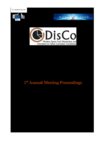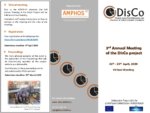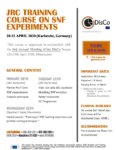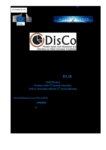DISCO: Modern Spent Fuel Dissolution and Chemistry in Failed Containers
DisCo aimed to fill the gap of knowledge on spent fuel dissolution arising from the development and use of novel types of fuel (Cr-doped and MOX). The project successfully determined that there is no significant difference in dissolution behaviour between the studied novel fuels and conventional uranium dioxide fuels. The project also enhanced understanding of spent fuel matrix dissolution under repository conditions including the development of a number of chemical models.
Overview
Project Dates: 1/06/2017 – 30/11/2021
Project Status: Finished
Project Website: www.disco-h2020.eu
The development of robust safety cases for geological disposal of spent nuclear fuel requires a solid understanding of its dissolution over very long timescales (up to a million years). Spent fuel dissolution is the main source term for the release of radionuclides under repository conditions and it will control the release of radioactivity in the environment surrounding the engineered barriers (the near field) of a disposal facility once the engineered barrier system has degraded and groundwater comes into contact with the spent fuel.
The DisCo project represented a logical follow-up of earlier Euratom projects (such as SFS, NF-PRO, MICADO, REDUPP and FIRST-Nuclides) which focused on dissolution and radionuclide release from conventional UO2 spent fuels. In this sense, this project aimed to fill the gap of knowledge on spent fuel dissolution arising from the development and use of novel types of fuel (Cr-doped and MOX).
The specific objectives of DisCo were:
- to enhance our understanding of spent fuel matrix dissolution under conditions representative of failed containers in reducing repository environments; and
- to assess whether novel types of fuel (MOX, doped) behave like the conventional ones.
Disco concluded that there is no significant difference in dissolution behaviour between the studied modern fuels and standard UO2 fuels. In connection to this, the project has improved the understanding of interfacial processes related to the dissolution, such as redox reactions.
DisCo was a collaborative project funded by the European Commission under the Horizon 2020 Research and Training Programme. The project was implemented by a consortium with 16 beneficiaries. The consortium was advised by an End User Group (EUG), consisting of waste management organisations in seven countries (Belgium, Finland, France, Spain, Sweden, Switzerland, and the UK) as well as regulatory authorities in five countries (Belgium, Germany, Spain, Sweden, and Switzerland).
Objective
While the scientific understanding of the dissolution of standard spent uranium oxide fuel had already reached a certain mature state, less was known about modern fuels, meaning those fuels doped with additives such as Cr or Cr+Al. Doped fuels are today included as a part of the concept of Accident Tolerant Fuels (ATFs). These types of fuels are increasingly used in reactors world-wide. It was therefore essential to establish if these modern fuels can be considered to behave like standard fuels in the repository environment. Dissolution data was therefore required to confirm that the dissolution behaviour of such fuels in a geological repository environment was similar to that of standard fuel. Similarly, there was a dearth of dissolution data from spent mixed oxide (MOX) fuels. Therefore, this project targeted oxide fuels containing additives, including Cr, Gd and Pu, in order to ensure that relevant characteristics could be understood to a level commensurate with standard fuels. This project aimed to expand the database on spent fuel dissolution with results from dissolution studies performed in truly reducing conditions, with hydrogen present. DisCo also aimed to investigate the effects of dopants through experiments using both spent nuclear fuel and synthetic materials specifically designed for the project. In addition, the project aimed to improve the understanding and description of the dissolution process relevant to the expected chemical conditions inside a failed waste container in a deep geological repository environment by employing chemical modelling.
Results
The Disco project concluded that there is no significant difference in dissolution behaviour between the studied modern fuels and standard UO2 fuels. In addition, the project has improved the understanding of interfacial processes related to the dissolution, such as redox reactions. Especially important is how hydrogen can slow down fuel dissolution due to inhibition of oxidative dissolution: the DisCo project has enhanced our knowledge regarding parameters affecting this process. This was achieved due to a complementary approach with spent nuclear fuel experiments, studies on model materials, and development of chemical models. The models developed included the solid state, the dissolution process, and reactive transport in the near field. With regards to the chemical environment, the results confirmed that low Eh and the presence of corroding iron and/or hydrogen is especially efficient in suppressing the dissolution rate. The DisCo project has developed models useful for safety assessments, as well as data and experimental methods important for research supporting safety assessments.













































